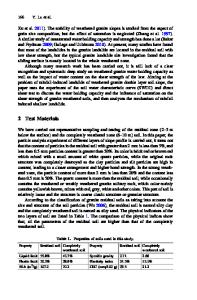Numerical study on strength and failure characteristics of rock samples with different hole defects
- PDF / 15,432,537 Bytes
- 18 Pages / 595.276 x 790.866 pts Page_size
- 90 Downloads / 382 Views
ORIGINAL PAPER
Numerical study on strength and failure characteristics of rock samples with different hole defects Shaojie Chen 1 & Zhiguo Xia 1 & Fan Feng 1,2 & Dawei Yin 1 Received: 14 May 2020 / Accepted: 25 August 2020 # Springer-Verlag GmbH Germany, part of Springer Nature 2020
Abstract In a rock mass, holes of various sizes and geometries naturally occur, which in turn can affect the mechanical properties of the rock mass. These defects often cause engineering problems in subsurface construction. In this study, PFC2D was used to perform uniaxial compression tests on a rock mass containing ten different types of hole defects to analyze their failure behavior and mechanical properties. Four failure modes were determined, and crack propagation and stress field evolution were studied. The results show that the hole defect reduces the uniaxial compressive strength, peak strain, and elastic modulus of a rock mass. Also, these defects accelerate the generation of cracks and promote the destruction of the rock. The failure modes can be classified as Ytype, inverted Y-type, upper left to lower right type, and upper right to lower left type. Before cracks are generated, the compressive stress concentration area is located on the left and right sides of the hole and distributed as a butterfly shape, and the tensile stress concentration area is located in the upper and lower parts of the hole. A zone where stress is decreasing is located near the tip of the tensile stress triangular area. The magnitude and concentration area of compressive and tensile stresses are greatly affected by various hole geometries. Finally, the maximum principal compressive stress decreases instantly after a crack coalesces. Overall, the hole shape has a noticeable influence on the stress distribution surrounding the hole, and a hole defect reduces the degree of failure of a rock mass. Keywords Different shape holes . Hole defect . Numerical simulation . PFC2D . Failure characteristics
Introduction Rock mass structure is critical for the stability of rock mass engineering. The existence of fracture, holes, and other defect structures in natural rock mass decreases the overall strength and affects the mechanical properties of the rock (Lin et al. 2013; Zhao et al. 2020; Wang et al. 2020). These can pose safety concerns during the construction of underground engineering projects, such as tunnels, reservoirs, and mines. Therefore, it is essential to study the failure characteristics and mechanical behavior of defective rock materials to
* Zhiguo Xia [email protected] 1
State Key Laboratory of Mine Disaster Prevention and Control, Shandong University of Science and Technology, Qingdao 266590, China
2
School of Resources and Civil Engineering, Northeastern University, Shenyang 110819, Liaoning, China
understand their unstable failure laws and predict engineering geological disasters of a defective rock mass. Scholars have conducted numerous studies on the failure characteristics, crack propagation, and mechanical properties of defective rocks
Data Loading...











